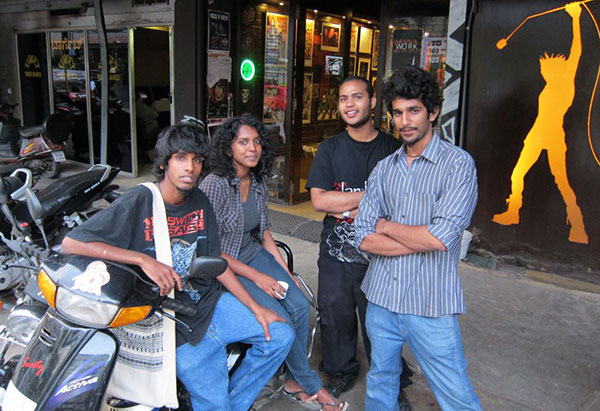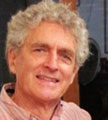I was DOP on the feature
SAMSKARA in India in 1969. It won a Silver Lion
at Locarno and The
President of India’s Award as Best Feature. It was
screened in Australia at the Opera House.
Over the years, I worked on a few other
films in India.
I formed a partnership
with Indian producers and directors and I was really
keen to work with my Indian
colleagues too. Of course it is a no-brainer
that we should have been
doing all we could to foster trade and societal
bi-lateral relations with India.
After I made ORANGE LOVE
STORY in 2004, an Indian partnership had seen that movie
and approached me to work
with them to make a similar movie set in
Bengaluru. So it was to be called
BANGALORE LOVE STORY.
Screen Australia couldn’t
cope with the development process. It is contrary
to the conventional
development process.
But ORANGE LOVE STORY was an
interesting movie.
It scored 3 and a half
stars from David and Margaret and was deemed ‘ONE OF
THE
BEST AUSTRALIAN FILMS OF THE YEAR’ by Adrian Martin in The Age. It got
very good audience response
at the Melbourne International Film Festival and
a few other festivals.

But to be fair here's a precis the Development process for BANGALORE LOVE
STORY that Screen
Australia couldn’t support.
LOCAL EMOTION PICTURES is
a workshop production method. It promotes as much
connection as possible between the
story, actors and their background. The
script is written from the people
and their stories.
Auditions are held to
find people whose stories personify the place where
the movie is set. Each
applicant tells a personal love story which is
recorded on video. The recording
provides potential story material and also
reveals more about the person
than a conventional ‘acting’ performance. In
conventional acting auditions the
applicants pretend to be characters –
instead, we try to find the
unique qualities of the person applying to be in
the movie. Actors are chosen
from their unique qualities – and the stories
they tell. For a real story
set in a real place, the characters must be
connected to that place.
As well as finding people
with qualities that give character to the place,
they (the actors) have to be
willing to avoid trying to be invented
characters. When actors try to
represent 'characters', or give performances,
it can be entertaining but
it diverts us from the essential mystery of the
person. To pursue that mystery,
we search for the deep, hidden needs and
desires of the characters. The
main thing practised in the workshop by the
actors is reading their
partners attitudes while pursuing their own desires.
This work engages the
actors in analysing their hidden desires. In
addition,
all love stories include the
tensions between the individual and society,
between tradition and modernity,
money and detachment, body, soul and mind,
good and evil, youth and age
– and innocence and experience.
BANGALORE has all this in
the extreme. The place is packed with vivid, comic
and tragic characters rich
with entertainment skills and there are brilliant
locations and situations. We must
celebrate this in the movie, especially
any actor’s special talent
and flair for entertainment.
In the script development
workshop, the chosen players work on scenes from
dramatic elements found in their
love stories (using improvisation). The
video-ed scenes are edited (distilled) and become part of the scripting
process. 'Story' is found in the
people and place where the film is made.
Rather than squash that
into the structure of the Hollywood/Film School
manuals, we work to discover a
film form in the alive stories. This involves
finding the ‘VISUAL AND DRAMATIC
RELATIONSHIP OF THE CHARACTERS TO THE
BACKGROUND’. We develop this as a
movie. In other words, this means
discovering the appropriate framing,
rhythmic, textural and sound
juxtapositions that suit the
character’s stories.
The method encourages the
camera operators to also go with the flow of the
improvised action rather than being
too premeditated. The camera needs to be
alive to the flow of energy
between the actors and to the changing
relationships of the characters to
their locality.
Capturing images is only
part of film-making, but for me, preparing to
capture those authentic
impulsive moments of courage and humour is crucial.
The whole production
process is a way of setting up and capturing those
decisive moments.
Scheduling the movie is
easy because everyone knows where they are in the
story.
Editing: A good editor
should participate early in the process in order to
discover and practise the
individual filmic style of the movie. And a
generous amount of editing time
is needed to arrange that mosaic. A huge
benefit in production would be
re-shooting. That would be encouraged by a
good editor involved in the
whole workshop process.
Some background: We (audiences) are engaged by what is inimitable about
people on the screen. And a
visual story can be found in the TENSION BETWEEN
THE FOREGROUND PERSON AND
THEIR BACKGROUND and we can explore that story in
the movie. This naturally
results in dealing with the SOCIAL CONDITIONS of
the place where we are
filming. Real social issues are exposed through this
way of depicting the
characters.
These issues generate
real emotions. The question is: what is the best way
to capture genuine and
spontaneous moments? Most of the actor’s preparation
is done to achieve an
unselfconsciousness (forgetting of themselves) while
they strive for their
desires. Preparing actors through scene analysis and
practice, through ‘Practical
Aesthetics’, is a good way to achieve those
moments of truth with actors.
When the crew is also technically
well-prepared and committed enough, we
will be filming at that moment.
We want to capture
something authentic about our lives – to depict the story
of people's true desires in
relation to the community and conditions where
they live.
Exhibiting
the Movie: Screenings will initially be at grass-roots venues in
keeping with the integral nature
of the production and maintaining
connection with the community.
OK, there's a bit more to
it than that – but I proved that it is a valid
process. I did a great job
complying with the tortuous Screen Australia
development application process. I
included the excellent credentials of my
Indian
partners.
You can see above some stills from the preparation.
Some bozo at Screen
Australia knocked it back.
Tom Cowan has directed the feature films THE OFFICE PICNIC, PROMISED WOMAN,
JOURNEY AMONG WOMEN, SWEET DREAMERS and ORANGE LOVE STORY.
|
